russian recoveries

Towards the end of my stay in St. Petersburg this past spring, I paid a visit to the “house-museum” of the poet Alexander Blok, where I snapped this photo of a small picture hanging in the back passageway connecting Blok’s study with his bedroom. There was no identifying label, but I presumed it to be Alexander Pushkin depicted there, moments after the senseless duel that was to take his life in 1837.
Fatally stricken, Pushkin sags against his seconds in the dimming field of snow.
The scene sets the model for the Russian poet’s prototypical death, blurring as it does the boundary between suicide and execution. It was a death repeated, with variations, by a whole line of Russian poets — by Lermontov (duel: 1841), Gumilev (execution: 1921), Khlebnikov (starvation & neglect: 1922), Esenin (suicide: 1925), Mayakovsky (suicide: 1930), Mandelstam (prison camp: 1938), and Tsvetaeva (suicide: 1941).
As for Blok, he was dispirited and broken at the end, dying with less drama though in more or less the same manner (visa denied for medical treatment abroad: 1921). Russia found a way to do all these poets in.
Or so I was thinking as I turned back into Blok’s study to gaze out his window again, wondering why I had come.
My friend Dedalus Wainwright and I were the only visitors in Blok’s museum that day, though in keeping with not yet abandoned Soviet labor practices at least ten babushkas were employed to keep an eye on the place, marking the empty hours with their cups of tea.
At the click of my camera, one of them had come over quietly to collect the 100 rubles ($3) apparently required for snapshots.
It was April. Through the [window][1], framed by long dark curtains, the day was dazzling. Remnants of glinting winter ice still bobbed on the narrow Pryazhka Canal, which curved under a couple of small arcing bridges as it made its way toward the larger waterway, the Bolshaya Neva river, where static cranes loomed over the dockyards. No ships moved in the currents beyond.
Blok’s desk, perfectly tidy, was at right angles to this view; a placard informed me that he had written nearly all his poems there. But now I imagined him not sitting in his desk chair but standing before his window, peering through the same glass I was.
The sun would have gone down and it would have been dark out. It would have been real winter, not start of spring.
It’s an old notion of mine, not much better than a superstition, that by somehow finding the same day-to-day glances that a person once took of a familiar place, you can enter that life a little yourself. Any secrets you manage to recover this way are the important ones — precisely because they aren’t. They’re out in the open, hiding in plain sight.
Of course there are better ways to bring back the thoughts of the poet — reading him being the most obvious. My lack of Russian kept that path largely closed to me; Paul Schmidt (about whom more later) had translated only a handful.
To my surprise, Dedalus happened to have memorized a particular Blok poem in Russian, and afterward when he recited it to me on the bank of the canal outside, I recognized it as the first in Paul’s posthumous book of translatons. The second of its two stanzas reads, first in Russian, then in Paul’s translation:
Умрешь – начнешь опять сначала
И повторится все, как встарь:
Ночь, ледяная рябь канала,
Аптека, улица, фонарь.Die, you only start all over
And it’s all the same as before:
Night, ice in the dark gutter,
The street, the street light, the store.
As I write this, I’m sitting at my own desk in upper Manhattan, where the Internet connects me to (and distracts me from) some of the bits and pieces I am trying to make sense of from here. Just now, it was a Google search that got me that Blok stanza in Russian.
One of the words — канала — has now caught my attention. Paul had rendered it as gutter, but online I find it defined as channel (or canal, as Charles Abbott has since informed me). So if it’s not a gutter but a channel or canal, then Blok almost certainly meant the Pryazhka Canal outside his window, a thought which has conjured up the following confusion of viewpoints in me:
I picture Dedalus reciting the poem as we stand on the bank, but I also feel (as if on the back of my neck) the gaze of the poet down from his window above.
Somehow from that vantage point Blok takes in not just the scene he describes in his poem but also my own future — and therefore phantom — presence within it.
Die, you only start all over.
nightmare
A recurring nightmare of my teenage years had me thinking I’d been woken up by the furtive movements of intruders in the dorm room in which I was sleeping.
As my eyes accustomed themselves to the darkness, I would discern the outlines of another room partly superimposed over mine, with ghostly figures going about their lives within it. Somehow it would come to me that this was the room of a house that once stood on the same spot as my school cottage; I pictured it as having burned down in colonial times, everyone aflame — something to do with New England witchcraft.
When it dawned on me that these ghosts were starting to become aware of me as an intruder in their space, my dread would mount until I’d wake up for real, my heart pounding and my eyes half-expecting to encounter the same figures again, only this time themselves fully awake and closing in on me.
I’d switch on the overhead light and write down the nightmare in the stenographer’s spiral notebook that I always had at hand — My Education, as my then-hero William Burroughs was later to call his own book of dreams. (This was the last book he was to publish in his lifetime, “pre-posthumously” so to speak, a used copy of which I bought for next to nothing the other day from a sidewalk vendor on Broadway.)
generations
This nightmare came back to me when I was meditating on the succession of lives in any given dwelling-place, especially old ones. How hard it is to recover any real sense of these lives, though they all must have left telltale traces.
Some such traces tell a tale at the Dostoevsky Museum in St. Petersburg, which occupies the apartment that the famous writer and his family tenanted in the final three years of his life.
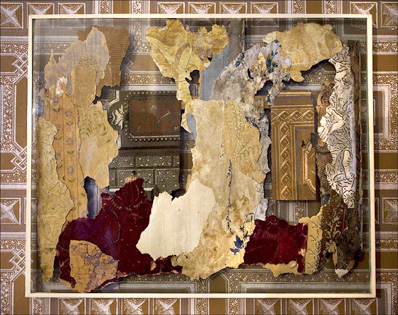
The first thing to strike you there is the variety of distinct wallpapers, a different pattern in each hallway and room. Just as you ask yourself how anyone could possibly have plumbed Dostoevsky’s taste in decoration, you come upon the explanatory exhibit pictured above, which Charles Abbott, an American artist-in-residence at the museum, kindly snapped for me.
It’s a superb piece of urban archaeology, the dig having been directed not down into the earth, but sideways into the wall, one paper-thin layer after another, until Dostoevsky’s stratum was reached (and somehow identified — I wonder how).
The museum has done its best to peel back time, restoring the apartment to the Dostoevsky version. On opposite arms of the apartment you find the two poles of his existence: the nursery in which he played with his children and the study in which he toiled and slept. The guided tour culminates in the latter room, where you encounter the desk where he wrote Karamazov and the divan where he lay down to die.
But if the museum has done a fine job of restoring the life of this notable author, it has necessarily been at the expense of the other ghosts there. I grant you that Dostoevsky did evoke the impoverished underclass of his city, to whom he gave fevered voice; Crime and Punishment in particular maps his vision onto the Haymarket district of St. Petersburg so powerfully that today tour groups visit the likely sites of the novel as if Raskolnikov, Alyona Ivanovna, and Sonya Marmeladov once actually lived and breathed there.
These urban types were indeed rescued from oblivion by Dostoevsky’s powers of imagination, but it’s also true that, in Viktor Shklovsky’s shrewd observation, such characters all seem to think alike, as if since childhood they have been reading the same author — Dostoevsky.
So rather than escaping the thrall of one man, the city and its lost inhabitants simply become, in the minds of his many readers, varied reflections of the author himself.
communal living
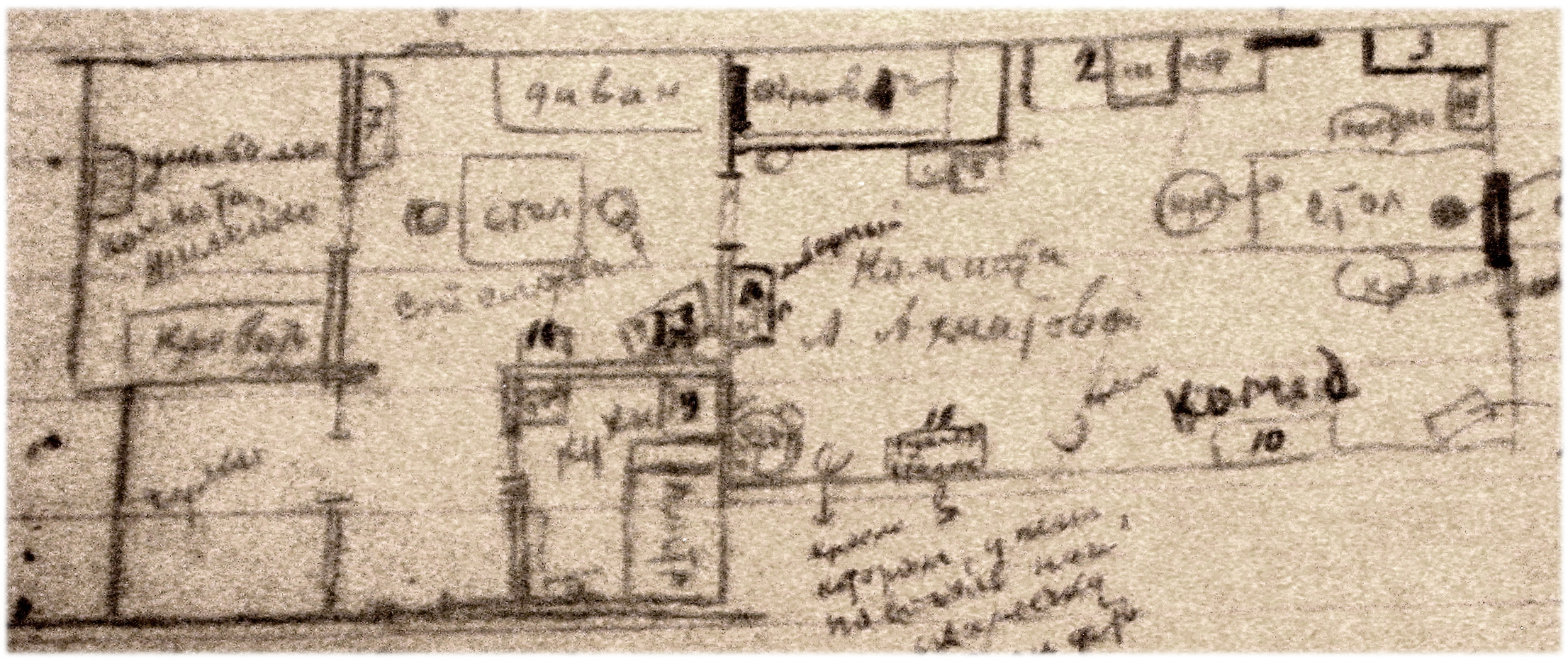
St. Petersburg is said to have found itself reflected very differently in the soaring poetry of Anna Akhmatova, but her living quarters brings her life, or at least your reading of it, right back down to earth. Her house museum is an altogether more elaborate and fussily interpreted affair than Blok’s, and as a consequence I managed to wrest far less from it than I’d hoped.
My camera did capture this detail of a penciled floor plan that I happened to spot in a crowded vitrine, where notes and letters lay under the reflective glass. I took this particular page to be a contemporaneous sketch of the complicated spatial and familial subdivisions that existed in the apartment sometime in the 1930s or thereabouts. However, since the accompanying sign was in Russian alone, you run the risk, as usual, of my having got this identification wrong.
It’s true that the divvying-up of apartment space in Soviet times was a fraught procedure. The prevailing Marxist doctrine gave no value to private property, which collective possession was supposed to have superseded, and in the communal apartments dictated by such policy, lives were thrown together in spaces originally designed for a very different mode of living. This is starkly apparent in the communal apartment that Akhamatova occupied for some thirty years, for it was carved out of the much larger space of the formerly aristocratic Fountain House, itself a part of the Sheremetev Palace.
The history of this living space made it peculiarly suitable for Akhmatova, who could take her place on both sides of its divide. As the noble poetess of 20th century Russian literature, didn’t she rightfully belong in a palace setting? But, as the bereft wife and mother giving voice to so many other Soviet women (who, like her, queued endlessly at police stations and prisons for any word of missing husbands and sons), wasn’t she also suited to the same sort of cramped communal quarters in which they were all living out their days?
The private life that Akhmatova led in this particular spot now reads in retrospect as an everyday Soviet soap opera. When she first moved in with her lover and eventual common-law husband Nikolai Punin, his soon-to-be ex-wife (also named Anna) merely shifted to a different room in the same apartment. Fifteen years later, when Akhmatova left Punin, the two Annas simply exchanged their rooms again. No one, it seemed, could get away from anyone else — unless of course it was the State that snatched them away, as it did Punin (arrested 1949, died in the Gulag: 1953).
But then no life was private in those days — or at least no life was supposed to be, and Akhmatova had to assume that the State was watching and listening to her everywhere and at all times. And so she composed verse inside herself, sub-vocally, and then took unusual measures to ensure its survival outside the confines of her head. Summoning a trusted friend into her room, she would chat idly about the weather for the benefit of the microphones hidden in the walls, a phantom policeman at the other end of the presumed wires. Meanwhile, she would silently write down her stanzas on slips of paper, burning each in an ashtray when her friend had committed it to memory.
Now, standing in the same room where this furtive transmission had once taken place, I’d had to abandon my idea that the doorways, walls, and windows of the place would have somehow retained at least a faint imprint of Akhmatova’s inward life there. In its misguided earnestness, the museum had succeeded only in smothering its subject. The rough English of its website claims that the literary display using new visual language creates a model of Akhmatova poetic world, but this visual language proved to be only kitsch — its design tried gussying up and poeticizing the array of photographs, letters, identity cards, and other artifacts on display there by interspersing them among new white pillars and sculpted figures, with a hugely blown-up photograph of the garden trees outside serving as a backdrop.
These elements were all meant to evoke the “White Hall” of Akhmatova’s Poem without a Hero, for many of whose sections she explicitly identified this House on the Fontanka as the setting, and more particularly the windows of the house, which served to frame her ghostly visitations.
But I felt only a kind of vacancy in the place; even when I stood at [Akhmatova’s window][3], nothing stirred in me.
shaky ground
But I was on questionable ground everywhere I went in Russia, partly because I was so hopelessly ignorant: I picked up virtually nothing of the language, never managed to decipher Cyrillic properly, had a hard time distinguishing between past realities and present ones, didn’t quite know what I was looking for—even though I was conscious of looking for something very intently—and when I did find a connection or make a discovery, I had every reason to doubt its validity.
When I got back to New York, it was as if half of me still lingered behind in St. Petersburg or Moscow, or perhaps on a train, white birch trees blurring by outside. I found myself trying to re-unite my divided soul by immersing myself in all manner of Russian translations, one of which was Nadezhda Mandelstam’s second memoir, Hope Abandoned, which I’d bought and half-read 25 years earlier. Now as I opened it up again, the glue of the spine disintegrated into gray dust, and white pages fluttered down to my tabletop. I rebound the book in sections using gray duct tape, which had the unintended but perhaps appropriate effect of making it seem like a samizdat edition. When insomnia kept me up at night, I busied myself with hunting down unfamiliar passages.
One such passage related Osip Mandelstam’s memories of his close friend and fellow poet Nikolai Gumilev, Anna Akhamatova’s first husband, whose abduction and execution by the secret police in 1921 foreshadowed Osip Mandelstam’s own fate seventeen years later. Mandelstam often recalled Gumilev’s responses to his poetry, and enjoyed repeating one of them in particular: > > This is a very good poem, Osip, but when it is finished, not a single one of the present words will remain. >
Delighted by this idea, I marveled over it for a bit, but then turned it back on myself more pessimistically. Perhaps a few of the observations that I’d brought home with me were promising, I thought, but if I were ever to get the whole picture right, probably not a single one of them would remain.
(This thought may explain the four month lapse between the start of this text and now.)
fatalism
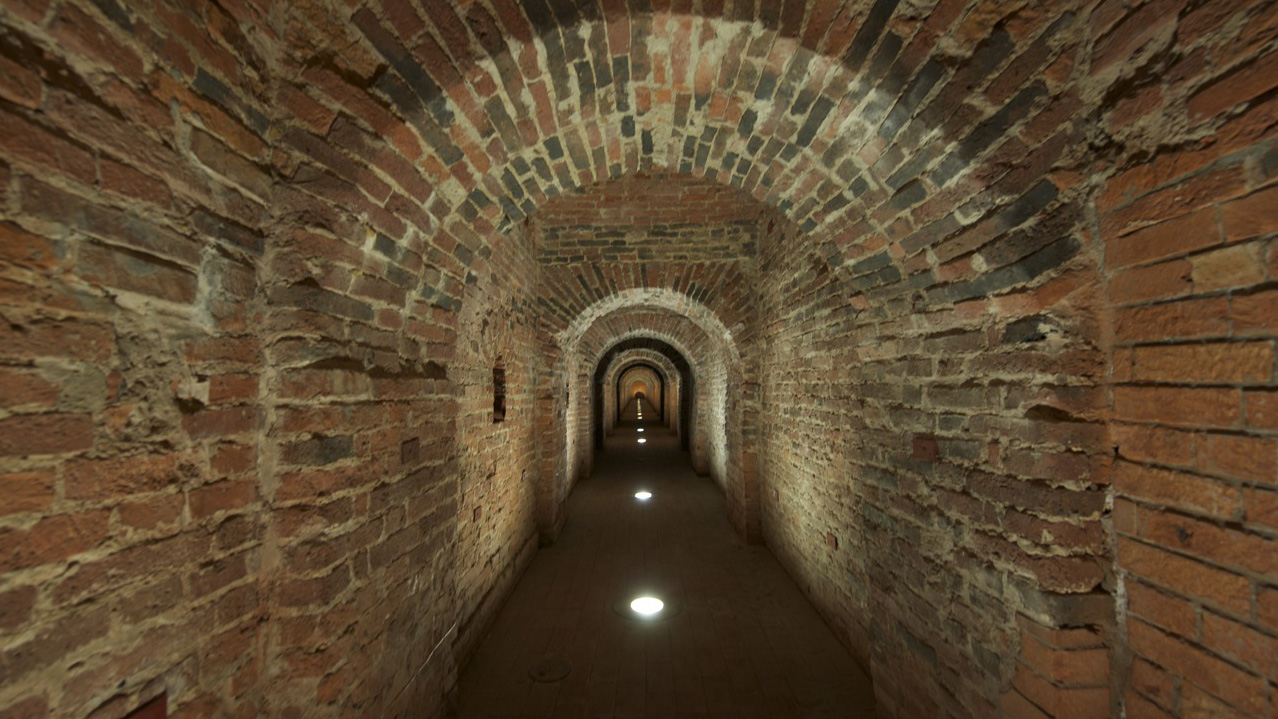
It’s true that pessimism gives way to fatalism all too easily in St. Petersburg. Many of its tourist sites commemorate the dismal fates of its citizens, a fact that was brought home to Marc Downie and me almost immediately upon our arrival in the city when we were taken to the site reserved for our [Point A to B][4] installation.
A taxi-ride across the Neva River conveyed us to Hare Island, where Peter the Great had erected the first part of his new capital, the Peter and Paul Fortress, to defend from the Swedes what was still a mere swamp off the Bay of Finland. Descending within the ramparts of the fortress, we proceeded down the so-called Secret Passageway that led to the vaulted brick chamber where we were to set up our piece.
The sense of this having been a dungeon was confirmed by our hosts, from whom we also learned that it had been somewhere in this vicinity that Peter the Great had had his own son Alexis tortured to death. On an exploratory walk around the small island a few days later, I was surprised to find that Alexis had been given a little resting place of his own there, a small side chapel in the Peter and Paul Cathedral at the center of the island, where the remains of the entire Romanov line were collected. A larger side chapel had been added in the late 1990s to house the questionable bones of Nicholas II and his family, exhumed from the pit in Ekaterinberg where they’d been tossed after execution by the Bolsheviks.
The architecture of St. Petersburg memorialized many other such bloody scenes, from Decembrists’ Square, where Nicolas I unleashed deadly fusillades on the futilely reform-minded rebels, to the garish Church on Spilled Blood, which marked the spot of Alexander II’s assassination by the Nihilists. Though off the usual tourist paths, the oppressive Bolshoy dom stood in plain sight on the Neva — the very place where the Stalinists interrogated, tortured, and often executed their many local victims during the Terror of the Thirties. It still functions today, incredibly, as a headquarters of state security.
But here you may fairly reproach me for confusing a sense of fatalism with a mere awareness of fatality. What makes the bloody history of St. Petersburg seem pre-ordained and unalterable rather than improvised and open-ended? Why do its figures seem to have been crushed by an implacable Fate that simply dwarfed them?
Perhaps it’s the very scale of the city. On first arrival, many of the state buildings, residences, churches, canals, and bridges look pretty familiar to anyone who knows Amsterdam or Paris or Venice. But that familiarity shrinks away when you begin to walk around — you find it taking you four or five times longer than you expected to go from point A to point B, the blocks are so long; and since that archway you’re passing under is more than ten times higher than it seemed from a distance, you’ve become a mere mouse by the time you scuttle through it.
false futures
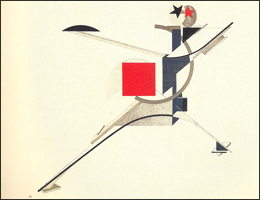
El Lissitsky, New Man (costume design) [detail]
But there was a moment in Russian history when those who’d armed themselves with the best new ideas strode the city and the country like giants, believing it well within their power to reinvent the world top to bottom. The tumult of the 1920s had them convinced that they could blow their future wide open.
That they turned out to be wrong — grievously so — is perfectly clear in rearview.
But what if we could avoid looking backward in the usual simple fashion? — forget that we already know how it all turned out? Could we find a different angle, one that lets us glimpse what they thought they were seeing at the time (even if much of it proved to be illusion)?
These at any rate were my desires. I longed to peer back through that brief window in time and watch all the speculated futures of the period spin themselves out — to see them before they diminished down to the Stalinist none.
I met with mixed success. The actual future — the present — had a foot on the neck of each alternative.
shunted
My first week in St. Petersburg I was too busy with other things to try tracking down more traces of the 1920s; and then my intention was briefly derailed by a probably pointless train ride to Petrozavodsk, a provincial capital 8 hours to the northeast, where we were to give an artists’ talk.
But as we pulled into a station along the way, Marc looked out the window and happened to spot a remarkable device — a special sort of train that had been shunted off on a nearby siding (too easy a symbolic ending).
A glance at the thing revealed how it worked: it could reach back to grab a fresh pair of rails from a stack behind it, swivel the pair forward to lay them down in front of itself, then advance over this new length of track, and repeat — thus, a train that can build its own route as it goes along.

Dedalus kindly drew this diagram of the mechanism]for me after we pulled out of the station again.
viktor shklovsky
My enthusiasm for this contraption was oddly displaced, for I felt I’d mostly borrowed my sense of it from someone else — from the spirit of Viktor Shklovsky (1893-1984), whom I’d been re-reading on the train ride.
Nothing suited Shklovsky better than a metaphor driven by machine; his prose runs the way a combustion engine does, with a series of controlled explosions that hurl the vehicle forward.
Here’s a literal example of an explosion going off in a paragraph — of Shklovsky accidentally blowing himself up while testing dubious safety fuses for a bomb (this in the 1920 campaign against the White Army, down near the Black Sea):
My arms were flung back; I was lifted, seared and turned head over heels. The air filled with explosions. The cylinder had blown up in my hands. I hardly had time for a fleeting thought about my book Plot as a Stylistic Phenomenon. Who would write it now?
Shklovsky’s colliding oppositions take things much farther than their better-known equivalents in Soviet film, as advanced most famously by Sergei Eisenstein, though perhaps that seems the case only because cinema has appropriated montage thoroughly (if trivially) while writing has largely fallen back on its old devices.
I first encountered Shklovsky’s work back in the 1980s, when friends had put me up for the night in their battered apartment on St. Marks Place. The street noise of early-morning garbage trucks had awoken me, stiff-jointed, on the living room floor, where I happened to spot an unfamiliar title in a teetering pile of books nearby. This turned out to be Shklovsky’s Third Factory, that most inventive of memoirs. Opening it at random, I read a paragraph or two, and haven’t stopped reading Shklovsky, off and on, ever since.
Shklovsky and his circle (Jakobson, Eickenbaum, Brik) were ardent theorists of literary form, and I suppose their ideas run in a direct line of descent first across Europe to the Structuralists in France and then outward to academic post-modernists ensconced seemingly everywhere around the globe. But we shouldn’t hold the originals responsible for the imbecility and bloodlessness of present-day Theory — it’s been the academic inbreeding of ideas that has led to the current sterility.
It puzzles me that Shklovsky still remains so obscure, known if at all for a few easy bits from his 1925 book Theory of Prose. Far more interesting than his theory of prose is his practice of it, which is best found elsewhere, in his autobiographical works. These have been unusually well-served by an American academic, Richard Sheldon, whose translations and contextual commentary open up Shklovsky about as wide as can be imagined in English.
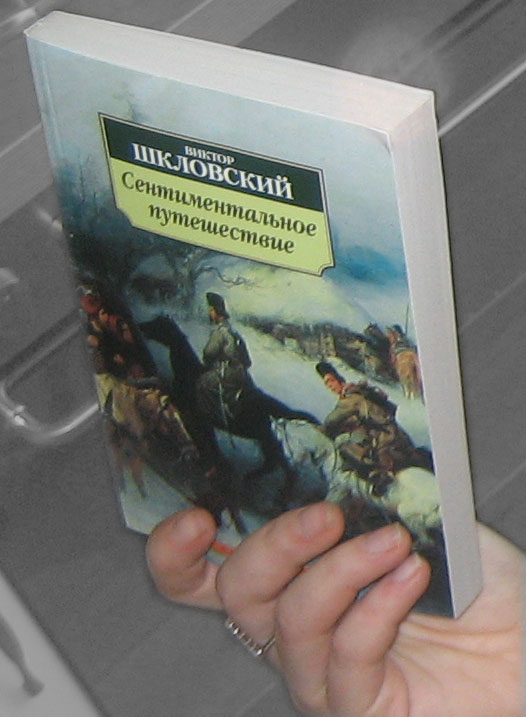
Now that I was in his native land, however, I was expecting to find a good deal more about the man, one of the few of his kind to have survived the Twenties and Thirties to live and work on to a decent old age. But in an early sign that contemporary Russia has little place for such figures, I found not a single Shklovsky volume in any of the main St. Petersburg bookstores; nor did I fare much better in Moscow, where with the help of my friend Alla Kovgan I turned up only a cheap paperback edition of Sentimental Journey, its experimental nature thoroughly disguised by the conventional genre illustration adorning its cover: three soldiers on horseback cross a wintry landscape.
Alla was determined that her homeland cough up more of Shklovsky for me than that, so she posted a request for Shklovsky on an online book exchange site. Dozens of sellers responded from across the country, but only one from Moscow. When she rendezvoused with him the next day, he offered her Shklovsky’s collected works in three large volumes, all for a mere 300 rubles (about ten bucks). “Who needs this kind of nonsense anymore?” the man said as he handed over the books to Alla, who nonetheless returned to strike a triumphant pose for me, cradling her trophies.
idolatry
We were staying in an apartment that belonged to a young Russian yoga instructor, who to my surprise made a comfortable enough living in Moscow to afford a nicely renovated and spacious flat.
The yogi adept and I had one thing in common: an interest in what we each supposed to be the wisdom of the east.
But my east was Russia — hers, India.
An object of my eastern pilgrimage was the Tretyakov Gallery — not the main building, but its distant cousin, the State Tretyakov Gallery, to which 20th century art was consigned. There, or so Alla and Dedalus had assured me back in New York, I was certain to find a rich trove of the Russian avant-garde, its only real repository in a country whose treasures had been carted off by the capitalist curators and collectors who’d placed so much higher a value on it.
So one morning I set off in the direction of that museum, which my map showed to be toward the river and across from Gorky Park. I walked the most direct route, which went along Sadovoye Kol’sto, a busy ring road meant more for cars, trucks, and buses than for people.
This took me past October Square, where a heroic statue of Lenin was now dwarfed by symbols of global capitalism — signs for Japanese consumer electronics companies. With their neon switched off, both Canon and Hitachi formed dull red letters against the overhanging sky.
Beneath the Hitachi name I could read its corporate slogan. In slightly awkward or at least incomplete English, it called on me to Inspire the next.
iconic
The museum, when I reached it, stood big, white, and listless on the embankment, with the river winds whistling around it.
The place was nearly empty, and not another soul was to be found in the collection I’d come to see. Then again much of the soul seemed to have vanished from many of the artworks I found there.
For example, from Malevich, whose Black Suprematist Square of 1915 was at one time a clean break from the past: an open door to the future.
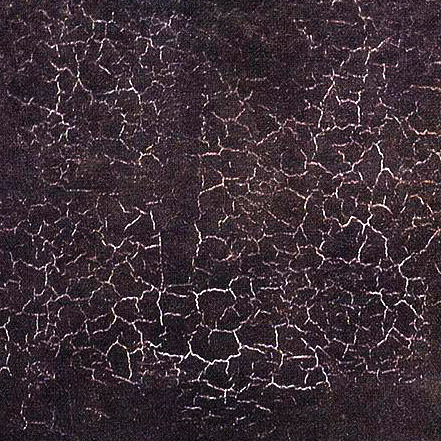
Now, it must be said, the artwork wasn’t wearing its age well; was in fact falling to pieces. Its black paint, somehow faded to a dark blue, had cracked into a network of crisscrossing white lines, disfiguring the purity of the square.
How differently this Malevich had fared from the Russian icons, many centuries older, that I admired later that afternoon at the main Tretyakov Gallery closer to the city center. It immediately struck me that the haloed saints of the icons had weathered the ages much more successfully than had poor Kazimir Malevich — perhaps had even gained in power by virtue of their long passage through the ages. Though the paint had partly seeped into or chipped off of the now warped and gnarled wood panels that served as their vessels through time, still the holy figures were unperturbed and undiminished — still they commanded the gaze of the more numerous viewers filing past them.
Not so Malevich. By the 1930s, in the ussr at least, his day was already done, his artistic revolution reversed by the larger Communist one.
In the Teens and Twenties, when everything was in upheaval, many had been fooled into thinking that both the artistic and the political revolutionaries were marching in the same triumphant parade. But by Stalin’s time this folly had been cruelly exposed. Stalin’s taste ran backwards, social realism was decreed the order of the day, and all artists were either pushed back into line or run into the ditch.
One would have supposed Malevich to be simply an innocent victim in all this, as indeed he was. Yet the quality of his innocence is something I now have cause to question. The seeds of my doubt were planted a little earlier, back in St. Petersburg, though they didn’t flower until after my return to New York.
veneration
On Nevsky Propect stands an American contribution to the St. Petersburg cityscape dating back to the early 1900s — the Singer Sewing Machine Company building, an art deco structure whose distinctive glass turret thrusts a Singer globe skywards. Long since converted to other purposes, the building now houses the city’s largest bookstore, Dom Knigi, which is where I’d first failed in my search for Shklovsky and where I then had to content myself with surveying the collection of art books on sale, my lack of Russian putting all but picture books out of my reach.
As I made my way back to the art book section, my attention was drawn to a glass cabinet on the side, where half a dozen different Bibles lay behind locked glass windows. Each Bible was bound in thick leather, as I seem to recall, and each had its unique cover embellished by an assortment of gaudy jewels. Equally gaudy were the price tags for these kitschy volumes, well over one hundred thousand rubles apiece, thus running in the 4- to 5,000 dollar range.
So much for atheism in Russia — the strenuous Soviet attempts to stamp out religion had backfired badly, though could any commissar have devised a better argument for atheism than these post-perestroika, conspicuous-consumption, luxury-item Bibles?
Moving on, I found the art books in the back to be devoted mainly to the treasures amassed by the tsars and their successors in the Hermitage museum, where Old Masters from Italy, France, and Holland were the main attractions. But at the bottom of a pile of discounted books, I came across a real discovery — In Malevich’s Circle: Confederates, Students, Followers, an English-language catalog for what had evidently been a large exhibit at the State Russian Museum. Beautifully printed, the volume reproduced many artists I’d never heard of, and since the whole thing was mine for a mere $14, I accepted the considerable weight it added to my suitcase.
cult
Only on returning to Manhattan did I do more than marvel at the paintings, posters, sculptures, ceramics, stage sets, transit designs, and other products of Malevich’s influence. Now I sat down to study the text properly, trying to make better sense of a movement that I began to realize was far more disciplined than I’d known.
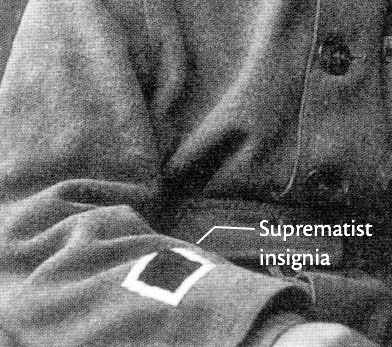
Black Suprematist square worn by Nikolai Suetin, 1922
—Disciplined being the operative word, for Malevich and his followers adhered as strictly to Suprematist theory, methods, and goals as did any radical ideologue to Marxism or religious fanatic to otherworldly doctrine. Disciples like Nikolai Suetin even wore the Suprematist black square as insignia on the cuffs of their overcoats, absurd as that may strike us today.
But nowadays it’s hard to conceive of art as more than a personal experience (at best) or as a social marker of taste and status. The utopian fantasies of Suprematism — Messianic in their certainty — were far more overarching than any we now entertain.
How strange it now sounds to hear Malevich proclaiming the Suprematist desire_to build the world up as a non-objective system, moving further and further away from the object, like the creation of the cosmos in nature_. And explaining to Osip Brik:
M: The surface of the world is not organized … It is covered with seas and mountains. In the place of this nature, I want to create a Suprematist nature, based on the laws of Suprematism.
B: What will we do with this nature?
M: You will adapt yourselves to it, just as you have adapted yourselves to the nature of the Lord God.
By Malevich’s reasoning, if the earth itself could be remade along Suprematist principles, so too could man. Malevich’s teaching was a form of reeducation, with methods not far removed from those of political indoctrination.
Many forms of brainwashing take a pseudo-medical approach, and so we find Malevich subjecting his student/patients to a precise course of treatment — from diagnosis and prescription, to dose and incubation, to surgery. The goal was to erase eclecticism in the art students and to develop pure sensations in each one. To that end, students were observed continuously, sometimes in isolation from each other, as their work was closely inspected and interrogated. Special tests registered their physiological reactions to color and color associations; other measures verified such things as the painterly dosage on the painterly conduct of the artist (whatever that could have meant).
Well, history had in store something other than the clinical fine-tuning of Suprematists for the Union of Soviet Socialist Republics — for example, the coercive mass production of Soviet comrades for Stalin (and, in the Great Terror, the paranoid purges from the ranks thus formed, sometimes of even the truest believers).
In any case, even as we note Malevich’s authoritarian bent, it’s a stretch to say it ever took significant hold. The words that most struck me in Malevich’s Circle were spoken in 1934 by the dying master. Expressing confidence in the the future of his own art, he doubted that of his disciples, one of whom poignantly quoted him in his diary that day: > > I am looking far ahead; perhaps when you are old, I will be understood. But all of you will be crossed out.
And it’s true that other than El Lissittsky, none of Malevich’s followers ever came close to matching the intensity and sweep of his originality. While Suprematist principles of composition did prove powerful even in weaker hands, designing for textiles and ceramics was surely not the revolutionary outcome they’d all once envisioned.
But on the other hand: were canvases? Even Malevich’s own?
mayakovsky
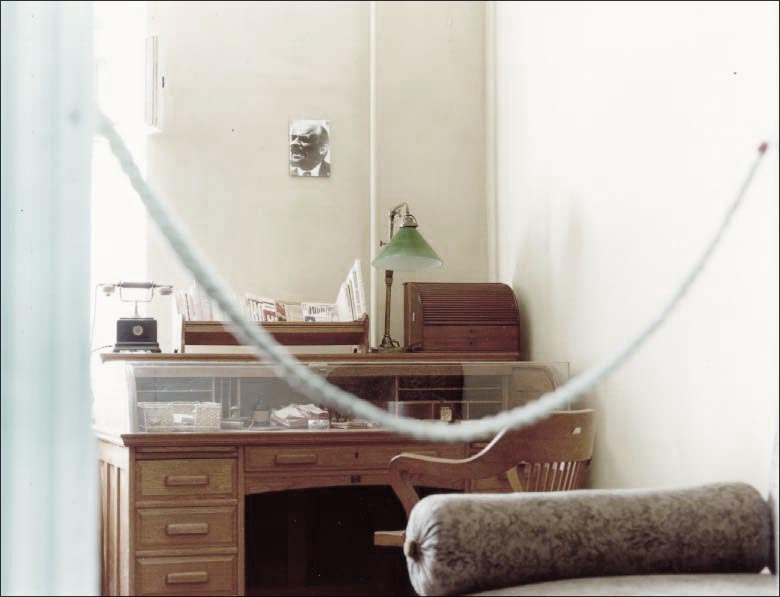
Mayakovsky's last room
The last “house-museum” on my list was Mayakovsky’s, in Moscow. It occupied several floors of the apartment building in which the poet had taken a room and had written his final pieces, the place where his suicide, shocking the nation, had finally discharged the line of a poem he’d written twenty years earlier — Let a bullet mark the period of my sentence.
150,000 Moscovites had thronged the streets for his funeral procession.
Nowadays the streets there surprise you by being so much quieter than those of New York or Paris. Even downtown near the Kremlin, the tolling of the bells at the Cathedral of the Assumption rises clearly above any traffic noise.
I remarked on this as I walked to the museum with Alla, who was researching a possible film on Mayakovsky and who had immersed herself in the man. The museum building was right off Lubianka Square — just past the notorious cheka headquarters in whose dungeon Mayakovsky would almost certainly have met his end had he not done himself in beforehand. As it was, his self-destruction in 1930 rendered him harmless to Stalin, who not only declared him the best of Soviet poets but issued his famous threat that “indifference to his cultural heritage is a crime.”
The Mayakovsky Museum proved to be the site of a different kind of crime — not of indifference, but of bad taste.
It was the same story, really, as at the Ahkmatova Museum, though because it aspired to the colossal tumult of Mayakovsky, it was an even bigger mess. The designers were after the same thing, though: a series of metaphorical spaces to interpret the poet’s life, heavy-handedly evoked with symbolic constructions loosely inspired by Mayakovsky’s life and works. The entrance, as described by the museum’s [website][8], is enough to warn you of what’s coming: > > The entrance to the Museum is performed in the post-modern style. There is taboo truss lying as a border at the memorial building as a symbol of interrupted time in the flow of current life.
Only the poet’s original room, with desk and bed, roped off at the entrance, is preserved as it was at his death — the rest of the museum spills over into larger spaces that were never his, its cascading exhibits all a-jumble with posters, publications, photographs, etc, done up in a forced and faked Futurist style that quickly had us looking for the door.
remaindered memories
What to do without the remaindered books that find their way so easily to my bookshelves? Two will now help show us to the end of this odd chronicle, though by what roundabout route I won’t know till I’ve written it.
The first is a collection of pieces by Roman Jakobson that had sat, half-read, in my studio for six years or so. When I got back and read it properly, Jakobson helped me overwrite the trivializing impressions I’d involuntarily gathered at the Mayakovsky museum.
For it turned out that Jakobson had lived in the building as well — had been there first, setting up the Moscow Linguistic Circle in the apartment his parents had vacated on the third floor, and later on, finding Mayakovsky a room to sublet on the floor above. The poet had been seeking a refuge to work in, a place apart from the complicated triangle he’d long formed with Lilya and Osip Brik.
Triolet eventually married Louis Aragon, the French poet who abandoned Surrealism for Communism.
For his part, Jakobson was also part of a lovers’ triangle, or rather a would-be one. The object of his I think unconsummated desire was Lilya Brik’s sister, Elsa Triolet, who also frustrated the ardor of none other than Viktor Shklovsky, whose epistolary masterpiece, Zoo, or Letters not about Love, was written to her.
So the two men were rivals in love. They were also allies and contenders in literary theory — but friends too, as revealed in the best anecdote of Jakobson’s book, one that brings the same building back to life:
Worried that his left-wing but non-Bolshevik adventures would soon have him arrested by the Reds, Shklovsky had been hiding out and sleeping in the thick bushes around the Church of Christ the Savior (before Stalin had torn this and a good many other Moscow churches down). Having decided to impersonate someone else, Shklovsky had come over to use Jakobson’s typewriter to falsify some old identity papers, for which he’d had the presence of mind to use pre-Communist orthography. He’d then stripped off his burr-covered clothing and was in the process of shaving his head when a professor of linguistics happened to drop by. Ignoring the unintroduced guest (as was the prudent custom in those days), the professor immediately launched into a scholarly discussion of Old Russian manuscripts — only to be surprised when the strange naked guy chimed in with a few learned points of philology.
Such were the peculiar conjunctions of those times…
return
— … times that Paul Schmidt thought were coming around again, an idea that first brought him to my studio sometime in the mid-90s.
That studio was on Spring Street in Soho, close to the Hudson River, which my windows framed perfectly. When the Queen Elizabeth 2 sailed to sea, it dwarfed the low warehouses on the waterfront, looking for all the world like a horizontal skyscraper taking leave of midtown: a curiously old-fashioned sight.
In the Thirties, El Lissitsky had proposed horizontal skyscrapers for Moscow, but since they were never built, you have to imagine them there.
A bit less imagination was needed for my Spring Street views, for they suggested things rather easily to you. For example, the buildings that housed Holland Tunnel’s air vents stood in the river and looked like castles, as everyone who came there exclaimed — castles with an enormous moat. They’d inspired one of Bob Wilson’s sets for Einstein on the Beach — a relevant fact for me in those days, since I was busy making Visionary of Theater.
It was in that connection that Paul Schmidt had come to hear of me. He’d known Wilson a long time, they having picked each other up on a street corner in Austin in 1960. More recently Paul had written the libretto for Wilson’s Alice (1994).
But when Paul knocked on my door, it wasn’t to talk about Wilson, but about Velimir Khlebnikov. He brought me a volume of his translation of the untranslatable: Khlebnikov’s Collected Works. (My copy was later lost, perhaps reshelved by mistake in Wilson’s archive down the hall.)
Paul had picked up on a kind of millennial feeling that was in the air then, which only intensified as the World Wide Web took off a little while later. Now he wondered whether the world Khlebnikov had foretold in the 1910s might not be revealing itself to us now, perhaps in the kind of hypermedia he’d heard I was exploring.
You’ve already seen that utopian ideas leave me cold, but I was interested in whatever conjunctions Paul could trace for me. He pointed me to such Khlebnikov texts as “The Radio of the Future,” which did accurately imagine such things as a game of chess between two people located at opposite ends of Planet Earth. Still, there was to this and the other essays a starry-eyed tone not much to my liking (like the flight of birds in springtime, a flock of news departs, news from the life of the spirit), not to mention considerable grandiosity (the invention of a universal language, a numerological system for prophecy, and so on).
Problems of tone also put me off the poems, heroic though Paul’s translations of them were — to match the intricate wordplay of Khlebnikov’s Russian, Paul had found all sorts of amazing English equivalents by delving deep down into the roots of our language and playing freely there. But in his introduction to his translations, he observed that “the use of neologisms and word games can be off-putting to the reader of English,” and sadly this summed up my case.
Meanwhile, I’d become more interested in the stories of these two men, Khlebnikov and Schmidt, than in the texts. The philistine’s usual fallback, you might be justified in saying.
numerology
When I went back to Paul Schmidt’s Khlebnikov recently, I tried tackling the part I’d found most problematic originally — the prophetic writings called The Tables of Destiny.

These were among the last things Khlebnikov wrote, and they reported the discovery of what he thought to be the pure Laws of Time, with which he could calculate time’s structure in powers of two or three, the lowest even and odd numbers. Stranger still, he maintained that an event always reverses itself, turning into its opposite state after a predetermined number of days.
By some obscure logic, the poet believed his equations to have the force of Jehovah’s Vengeance is mine, and I shall repay. This helps explain the patterns he then kept calculating, like this one:
Behavior and punishment, act and retribution.
Say the victim dies at the initial point.
The killer will die after 35.
Which works as well for an individual destiny,
The military agent Min put down the Moscow uprising on December 26, 1905; he was killed 35, 243 days later, on August 26, 1906.
as it does for a historical one:
Bulgaria was conquered by the Turks at the battle of Tvnovo on July 17, 1393; 311 days later a reverse event occurred: she was declared independent by the treaty of Berlin on July 13, 1778.
The ravings of a crackpot? — without question. But what had brought him to this?
Khlebnikov first started searching for the laws of time, he said, in 1915, on the day after the Battle of Tsushima — that is, on the day after the Japanese navy had destroyed the Russian fleet, taking more than 4,000 Russian lives. I wanted to discover the reason for all those deaths, he wrote — and soon, no doubt, the reason for the millions more that the Russian Civil War began piling up around him. And then for his own death as well, which was fast approaching in 1922 when he wrote this partial account of the Tables, having only six months left to live.
On his deathbed (as I hope I recall correctly, for I can’t put my finger on the source) he insisted on wide open windows, the better to disperse the smell of his bodily decay. Now I imagine him there calculating his own eventual reversal — which would have had him springing right back from death into life.
He would have risen up with the like-minded ones of his razed generation, some of whom had dubbed him The King of Time. With these Tables, Khlebnikov thought he’d legitimized his crown.
But in the end he was, like so many others, not the king, but only the victim of his times.
transmission
So, too, was Paul Schmidt, but in one way only: he had aids. It was death by sexually transmitted disease, rather than by starvation or war, that was the scourge of his particular time and place and person.
Apparently he’d acknowledged his illness to friends only a little while before we met. Even then he avoided the word aids, preferring the virus, which he pronounced distastefully — as if the word were, like the infectious agent itself, foreign to him.
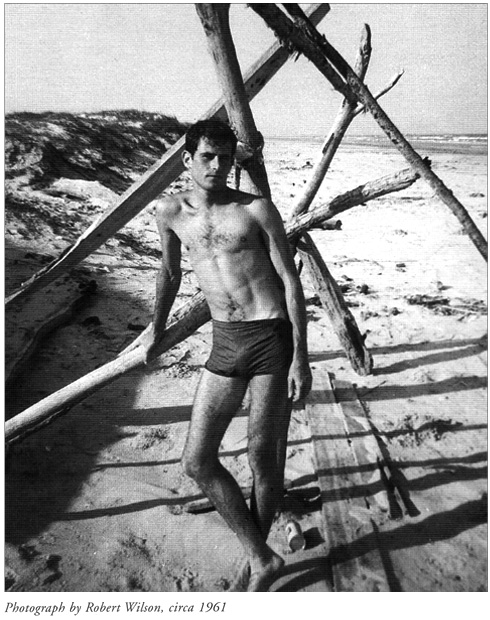
Little else was. Paul embraced everything, everyone — he was a translator, poet, actor, scholar, bon vivant, and sophisticate. In earlier days, he was also said to have been the most beautiful of men (as snapped at the beach by Robert Wilson in 1961), never bashful about using his attractions to full effect.
But I’m afraid I’m the wrong person to do him full justice, not only because I knew him only in his last few years, but because a good part of him was largely lost on me — his elegance, for example, or his knack for the grand gesture. At Paul’s memorial service, someone recounted his last adventure, undertaken not more than one week before he died. Substituting tuxedo for hospital gown, he’d had two old friends spirit him off for a final elegant evening at the opera. When I visited him a day or two later, he passed over this and we spoke as usual about more serious things.
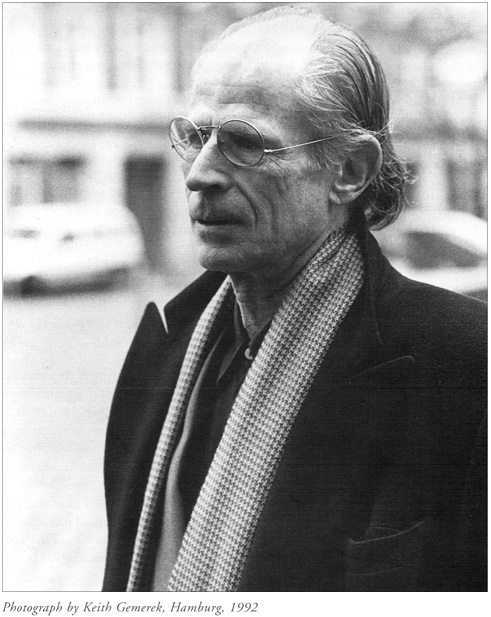
So what did we talk about? All this — literature and life and fate — though with more wit than you’ve encountered in my rather mournful account here. Paul connected me to many things I was curious about, and he did so generously: when he told me something new, he acted as if he were merely reminding me of it.
Although Paul was ever-weaker in his last days, he was still attentive, still intent on somehow hanging on a bit longer. It’s a cliche to say that he was at greater peace: his ease may have been drawn from the sedatives dripping into his bloodstream. But he seemed less beset by pain, free of the horrible cough that used to ambush him so mercilessly.
I remember that cough most painfully from our time in Jerusalem a year or so earlier. There were moments when I was almost as wracked by it as he was — in my case by the guilt I felt over having invited him there. I’d brought him in as the writer for an Israeli museum project we were doing with Robert Wilson, the absurdity of which I’ve related elsewhere.
This was a good time to be in Palestine, for it was in the interlude between the two intifadas, when peace seemed just over the horizon. Someday I’ll reconstruct the long and miraculous walk I took in Jerusalem and the West Bank, along a route only ghosts could travel today.
But while Paul’s time in Jerusalem had its low points, triggered mainly by those fits of coughing, it also had its highs. Many situations tickled his fancy there — for example, that one of the city’s more elegant old restaurants happened to be in the YMCA — The Young Men’s Christian Association, as Paul liked to draw the name out wryly. We made a good audience at dinner, Marco Steinberg and I, listening raptly as Paul told one story after another.
This was a form of oral transmission, I suppose, though I’m one of its weaker links, forgetting much that I’ve heard. Decades earlier, at Harvard, Paul had done far better — absorbing Russian poets through the inspired teaching of Roman Jakobson, whose flight from the ussr had eventually landed him in America. There in Cambridge he channeled Khlebnikov and Mayakovsy for his students in the same way the two poets had once recited themselves for him in Moscow.
Since for Paul the act of translating was above all a performance, he took from Jakobson’s spirited Russian renditions all the presences, rhythms, and tones he later aimed for in English.
last vessel
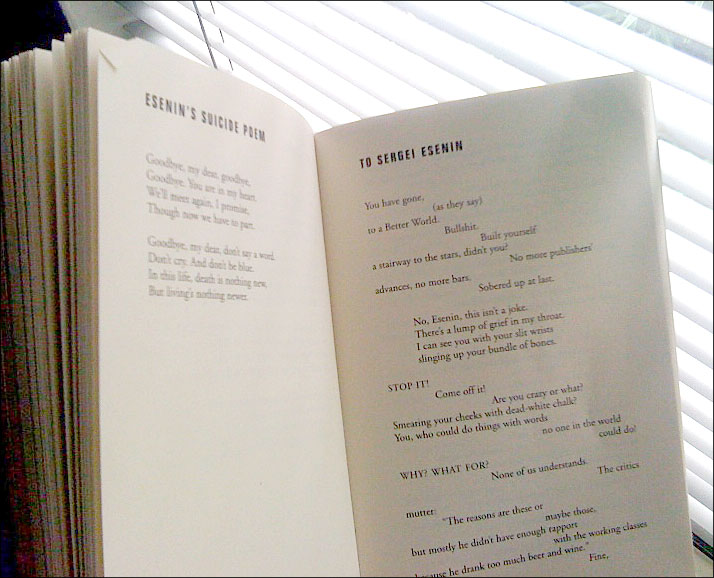
I don’t know how the posthumous publication of Paul’s last book, The Stray Dog Cabaret, could have slipped by me at first, but eventually I discovered it among the remaindered copies at my local bookstore. As I leafed through the pages, a clear image of the papers on Paul’s desk came to mind, conjured up either from memory or imagination — I did remember that when I’d last visited Paul in his apartment, he’d mentioned having been tinkering with the translations of just a few last Russian poems. Knowing his gift for understatement, I should have been a better translator myself: a few meant quite a few.
The editors followed Paul’s practice of arranging the poems in conversational series, as he had done, for example, in a sequence on suicide. Sergei Esenin’s suicide poem of 1925 is rebuked in a poem by Mayakovsky, who ends up writing one of his own, however, five years later — which is in turn answered by Marina Tsaeteva’s gentle reproach of both her departed friends.
These translated voices spoke to me during my time in Russia, where my dog-eared paperback copy rode with me in my coat pocket. Paul said the American verse of Walt Whitman, in translation, had shaped the irregular lines of Khlebnikov and Mayakovsky, which made me wonder if some such influence might cross over the other way.
I’ve dreamed of setting up a series of mirrors, angled so that they’d reflect not only across space, but across decades. I’d hang one such mirror in the phantom “house-museum” I imagine establishing at Paul’s now-dispersed studio apartment in the London Terrace complex on West 23rd Street — the mirror’s frame to be round, like a porthole.
Paul had modeled his room in the compact style of an old ocean-liner stateroom, with bookshelves, cabinets, and Murphy bed built in to beautifully carpentered woodwork. Its windows opened onto the gardens of the building’s inner courtyard just below, but now that Paul is no longer at the helm of his desk there, the scenery has started to slide away behind the glass, our vessel having cast off and set sail for the open…